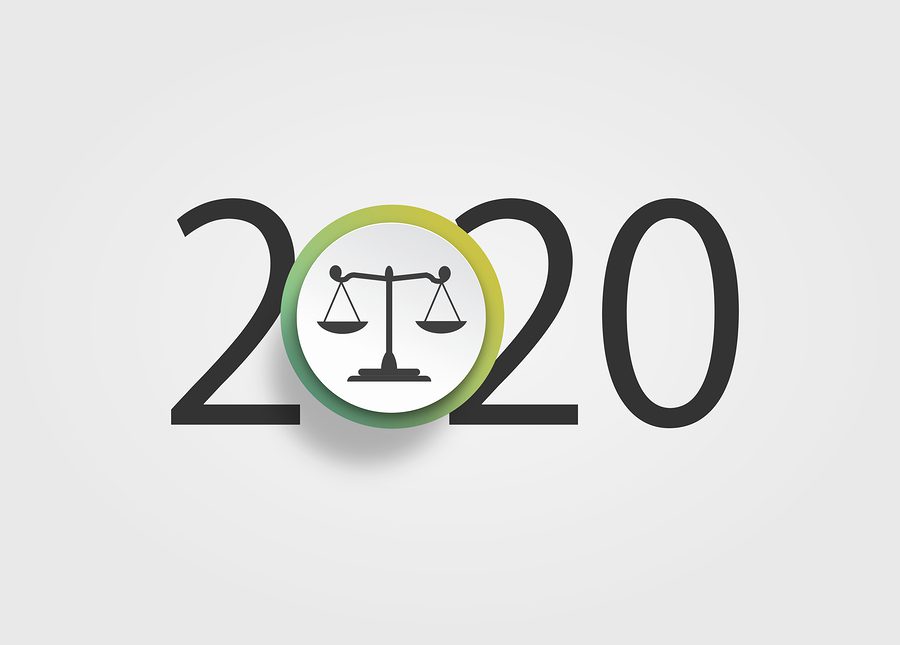The following is a brief overview of some key issues that may dominate the legal landscape in 2020 and beyond.
LGBT Rights
Due to its significant impact on the civil rights of more than eight million LGBT individuals in this country, this is without question the most hotly-anticipated court outcome of the coming year. On October 8, 2019, the United States Supreme Court heard oral argument in three cases involving employees who allege they were terminated from their employment because of their LGBT statuses in violation of Title VII of the Civil Rights Act of 1964 (“Title VII”); specifically, the statute’s prohibition on discrimination “because of sex.” Two of the three cases – Altitude Express v. Zarda (2d Circuit) and Bostock v. Clayton County, Georgia (11th Circuit) – involve employees alleging their respective employers discriminatorily ended their employment because they were gay. In the third case, R.G. & G.R. Harris Funeral Homes v. EEOC (6th Circuit), the federal government argued that the employer terminated an employee based on transgender status in violation of Title VII.
Aside from these three cases before the nation’s highest court, the protection of LGBT rights has garnered widespread attention in the private and public sector alike. Examples include The Business Statement for Transgender Equality, a letter penned by some of the nations’ largest employers that censures any reduction in LGBT rights, and the Equality Act, a bill passed in the U.S. House of Representatives that seeks to modify civil rights statutes to expressly protect LGBT individuals in the same manner as race, sex, national origin, and religion. Since its passage in the House, the Equality Act has sat at the Senate without much activity, however, the pressure to address the bill may build as the clock ticks on the Supreme Court’s forthcoming decision, due from the Court before the close of the 2019-2020 session on June 30, 2020.
Equal Pay for Women
In March 2018, members of the United States Soccer Women’s National Team (“WNT”) sued the United States Soccer Federation, Inc. (“USSF”) in the Central District of California seeking injunctive relief, back pay, and punitive damages under the federal Equal Pay Act – an amendment to the Fair Labor Standards Act that requires equal pay for men and women for equal work – and Title VII. The lawsuit, a class and collective action, was filed by female WNT players including Alex Morgan, Megan Rapinoe, Carli Lloyd, and Julie Ertz, who have become household names due to their overwhelming success in the international soccer world. Four World Cup championship titles, four Olympic gold medals, and the Number 1 world ranking in 10 of the last 11 years, among other factors, lead the WNT to argue that they unfairly receive lower pay and inferior playing, training, travel, and other conditions of employment when compared to those benefits provided to their Male National Team (“MNT”) colleagues, who have not enjoyed similar playing successes as the women.
This case is unique, not only because of its high-profile parties, but also because Defendant USSF does not appear to deny paying less to WNT players than MNT players, and instead asserts that “market realities” dictate their lower pay. The WNT is fighting this assertion with data they argue indicates the WNT not only is more successful on the field, but generates significantly more revenue for USSF than the MNT. Many compare this case to Billie Jean King’s efforts in the 1970s to equalize pay for women in professional tennis, and see it as another opportunity to increase awareness of unequal pay for women in sports and other industries. The case is currently set for trial in May 2020, just three months before the summer Olympics, where the WNT is expected, once again, to be a strong contender for the gold medal.
Age and Gender Discrimination Related to Online Ad Practices
The Communications Workers of America (“CWA”) filed Communications Workers of America v. T-Mobile US, et al. in May 2018, as a proposed class action lawsuit alleging that many major employers including Amazon, T-Mobile, and others yet to be named have used a paid advertisement posting platform on Facebook to post job opportunities and exclude older workers from applying. The suit alleges that Facebook’s platform allows posters to identify parameters for their employment ads to reach only targeted audiences, and thereby exclude potential audiences in a certain age brackets. CWA asserts in its lawsuit that this practice by employers violates the Age Discrimination in Employment Act, which prohibits discrimination on the basis of an employee’s or prospective employee’s age. The case is still in its early stages and has largely focused on whether CWA is a proper plaintiff in the lawsuit, but it is expected to gain attention as the case progresses. Similar lawsuits have been filed in other jurisdictions, and to add fuel to the fire, the Equal Employment Opportunity Commission (“EEOC”) issued a decision in September 2019 that the agency found “reasonable cause” to determine that seven employers, including Capital One and Edward Jones, had discriminated against females and older workers by posting job listings on Facebook using audience parameters including age and gender. In response, Facebook has reportedly modified its advertisement posting platform so that it prevents self-identified employers from posting job ads using age or gender-based audience-selection criteria. Skeptics may argue this is not enough because employers who do not self-identify their ad as a job posting may circumvent the restrictions and continue to exclude ad viewers based on legally-protected characteristics.
Joint Employer Classification
Three major federal agencies that enforce employment laws – the National Labor Relations Board (“NLRB”), Department of Labor (“DOL”), and the EEOC – all promised to revise their standards for determining when multiple, otherwise unrelated entities can be considered “joint employers” of an employee or group of employees. On January 12, 2020, the DOL issued its final rule regarding joint employment and the Fair Labor Standards Act, which is expected to take effect in mid-March 2020 and finalizes the proposed rule unveiled last year. The DOL’s rule replaces a much laxer test that said employers jointly employ workers whose work for one “is not completely disassociated” from their work for the other. Under the newly announced rule, the DOL will apply a four-factor balancing test to determine whether two or more affiliated businesses jointly employ workers in situations where workers perform tasks for one employer that simultaneously benefit another business or individual. These factors include:
(1) whether a business can hire or fire employees,
(2) whether it controls their schedules or conditions of employment to a substantial degree,
(3) whether it determines workers’ pay rates and the methods by which they are paid, and
(4) whether a business maintains workers’ employment records.
The NLRB and EEOC’s joint employment guidance is also expected this year. The NLRB has issued proposed rules, on which it has accepted public comment, and final rules are believed to be imminent. The EEOC indicated it planned to issue a notice of proposed rulemaking at the end of 2019, but the end of the year came and went without this notice. Employers are hopeful that the agencies will issue consistent rules and provide useful and practical guidance for employers as they consider the pros and cons of entering into various contracting and leasing relationships.
State and Local Law Developments
California Assembly Bill 5 (“AB5”) became effective January 1, 2020 (except for a limited exception for truckers). AB5 adopts the “ABC test” to determine whether a worker is an employee or independent contractor. The test is considered restrictive and would result in more workers being classified as employees. Other states, including New York, New Jersey, and Illinois, have also begun working on similar independent contractor standards modeled after AB5, and are expected to submit those for passage into law perhaps this year.
Another development arising from the Golden State, arbitration law reform Assembly Bill, seeks to criminalize arbitration agreements required as a condition of employment, even when employees are allowed to opt out. But the law has been challenged on constitutional grounds and was stayed by the United States District Court for the Eastern District of California, pending further hearings on the matter. Other states may consider similar laws and use the pending litigation as a lesson learned in drafting their own versions of the law so as to avoid the potential legal pitfalls of the pioneer laws in this area.
Finally, state law overtime requirements that exceed the federal law standards, paid and legally-protected family and sick leave, and predictable work scheduling are all areas in which there is a growing trend for states and local governments to enact worker-protective laws. Expect additional legislation on both a state and local level in these areas as well.
Reference: Laura Lawless, Esquire, Squire Patton Boggs, January 14, 2020

